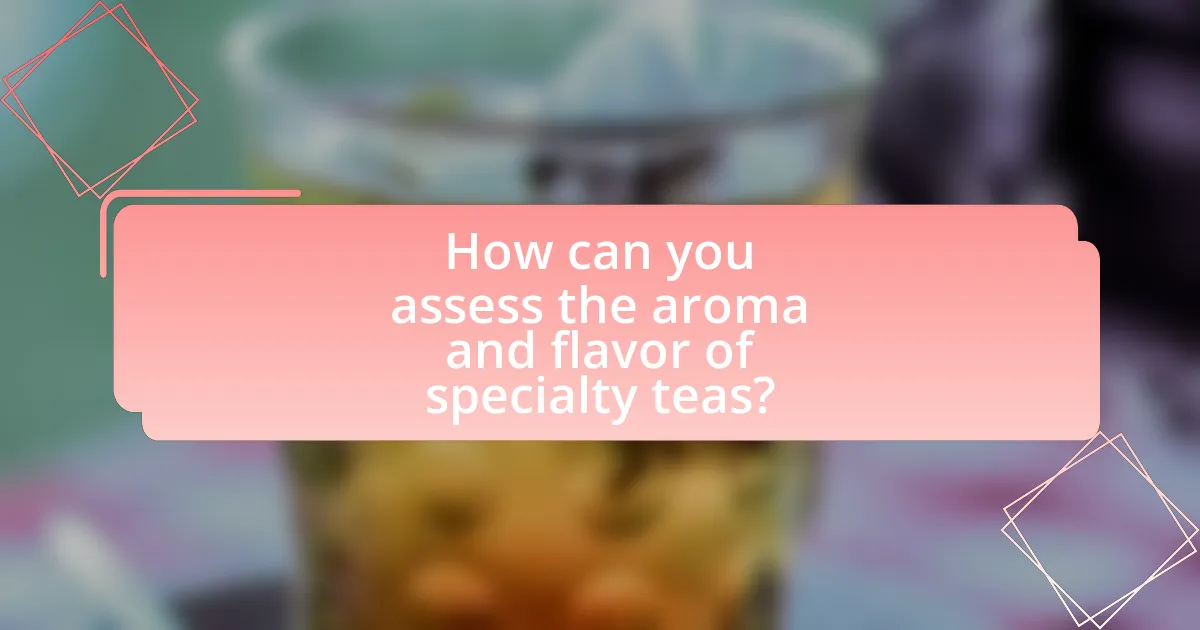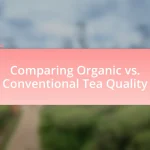The article focuses on identifying quality in specialty teas, emphasizing key factors such as the origin of tea leaves, cultivation methods, and processing techniques. It highlights how specific regions, like Darjeeling and Uji, contribute unique flavor profiles influenced by terroir. The piece also details the characteristics of high-quality tea leaves, the importance of visual indicators, and the role of aroma and flavor complexity in assessing tea quality. Practical tips for evaluating specialty teas through sensory analysis and resources for further learning are also provided, making it a comprehensive guide for tea enthusiasts and connoisseurs.

What defines quality in specialty teas?
Quality in specialty teas is defined by factors such as the origin of the tea leaves, the cultivation methods, and the processing techniques used. High-quality specialty teas typically come from specific regions known for their unique flavor profiles, such as Darjeeling in India or Uji in Japan. Additionally, the cultivation methods, including organic farming and hand-picking, contribute to the overall quality by ensuring that only the best leaves are selected. Processing techniques, such as withering, rolling, and oxidation, further enhance the flavor and aroma, making them distinct. For instance, studies have shown that teas processed with traditional methods often exhibit superior taste and aroma compared to mass-produced varieties.
How can the origin of tea influence its quality?
The origin of tea significantly influences its quality due to factors such as climate, soil composition, and cultivation practices. For instance, teas grown in regions with optimal climate conditions, like the high altitudes of Darjeeling in India, often exhibit unique flavor profiles and aromatic qualities that are highly sought after. Additionally, the terroir, or the environmental conditions in which the tea is cultivated, affects the chemical composition of the leaves, leading to variations in taste and aroma. Research indicates that the specific minerals in the soil can enhance the flavor characteristics of the tea, as seen in the famous Yunnan province of China, known for its rich, mineral-laden soil that contributes to the distinct taste of its Pu-erh tea. Thus, the geographical origin of tea plays a crucial role in determining its overall quality and flavor profile.
What regions are known for producing high-quality specialty teas?
Regions known for producing high-quality specialty teas include Darjeeling in India, Uji in Japan, and the Wuyi Mountains in China. Darjeeling is renowned for its distinct muscatel flavor and is often referred to as the “Champagne of teas.” Uji is celebrated for its high-quality matcha and gyokuro, benefiting from ideal climate and soil conditions. The Wuyi Mountains are famous for their oolong teas, particularly Da Hong Pao, which are characterized by their complex flavors and aromas. These regions have established reputations based on their unique terroirs, traditional cultivation methods, and stringent quality control, ensuring the production of premium specialty teas.
How does terroir affect the flavor profile of specialty teas?
Terroir significantly influences the flavor profile of specialty teas by encompassing the unique environmental conditions, soil composition, and climate of the tea-growing region. These factors contribute to the chemical composition of the tea leaves, which in turn affects the aroma, taste, and overall quality of the brewed tea. For instance, teas grown in high-altitude regions often exhibit a more complex flavor profile due to slower leaf maturation and increased exposure to sunlight, which enhances the development of aromatic compounds. Additionally, specific soil types can impart distinct mineral qualities to the tea, further diversifying its flavor. Studies have shown that teas from regions like Darjeeling in India are renowned for their muscatel flavor, attributed to the unique terroir of the Himalayan foothills.
What role do tea leaves play in determining quality?
Tea leaves are fundamental in determining the quality of tea, as their chemical composition, processing methods, and physical characteristics directly influence flavor, aroma, and overall sensory experience. High-quality tea leaves typically exhibit vibrant color, intact structure, and a rich concentration of essential oils and polyphenols, which contribute to desirable taste profiles and health benefits. For instance, studies have shown that the presence of specific compounds, such as catechins and flavonoids, correlates with higher antioxidant activity, enhancing the tea’s health-promoting properties. Additionally, the origin of the tea leaves, including factors like altitude and climate, plays a significant role in flavor complexity, with premium teas often sourced from specific regions known for their unique terroir.
What are the characteristics of high-quality tea leaves?
High-quality tea leaves exhibit several key characteristics, including vibrant color, intact structure, and a rich aroma. Vibrant color indicates freshness and proper processing; for example, green tea leaves should be bright green, while black tea leaves should have a deep, dark hue. Intact structure, meaning whole leaves rather than broken fragments, suggests careful handling and enhances flavor extraction during brewing. A rich aroma, which can range from floral to earthy, indicates the presence of essential oils and compounds that contribute to the tea’s overall quality. These characteristics are essential for ensuring a superior tasting experience and are often used by connoisseurs to evaluate specialty teas.
How does the processing method impact the quality of specialty teas?
The processing method significantly impacts the quality of specialty teas by influencing flavor, aroma, and overall characteristics. Different methods such as withering, oxidation, and drying determine the chemical composition of the tea leaves, which directly affects the final product’s taste profile. For instance, green teas undergo minimal oxidation, preserving their fresh, grassy flavors, while black teas are fully oxidized, resulting in richer, bolder tastes. Research indicates that specific processing techniques can enhance or diminish the presence of desirable compounds like catechins and flavonoids, which are crucial for both flavor and health benefits. Therefore, the choice of processing method is essential in defining the quality attributes of specialty teas.
Why is the appearance of tea important for quality assessment?
The appearance of tea is crucial for quality assessment because it provides immediate visual indicators of freshness, processing methods, and overall quality. For instance, high-quality tea leaves typically exhibit vibrant colors, uniform size, and a glossy sheen, which suggest proper handling and minimal oxidation. Research indicates that visual characteristics, such as leaf shape and color, correlate with flavor profiles and aroma intensity, reinforcing the importance of appearance in evaluating tea quality.
What visual indicators should you look for in specialty teas?
In specialty teas, look for vibrant color, whole leaves, and a uniform appearance as key visual indicators of quality. Vibrant colors indicate freshness and proper processing; for example, green teas should have a bright green hue, while black teas often display rich, dark tones. Whole leaves suggest careful hand-picking and minimal processing, which are essential for preserving flavor and aroma. A uniform appearance, with consistent size and shape, reflects quality control during production, ensuring that the tea brews evenly. These visual characteristics are commonly associated with high-quality specialty teas, as they directly correlate with the tea’s flavor profile and overall quality.
How does leaf size and shape correlate with quality?
Leaf size and shape significantly correlate with the quality of specialty teas, as these characteristics influence the tea’s flavor, aroma, and overall sensory experience. Larger leaves often indicate a more mature plant, which can lead to a richer flavor profile, while smaller leaves may suggest younger plants that produce lighter, more delicate flavors. Additionally, the shape of the leaves, such as twisted or rolled forms, can enhance the extraction of essential oils and flavors during brewing, contributing to a more complex taste. Research has shown that specific leaf shapes and sizes are associated with higher quality grades in teas, as they affect the concentration of phytochemicals and essential oils that define the tea’s unique characteristics.

How can you assess the aroma and flavor of specialty teas?
To assess the aroma and flavor of specialty teas, one should engage in a systematic evaluation process that includes visual inspection, aroma assessment, and taste testing. First, visually inspect the dry leaves for color, shape, and uniformity, as these factors can indicate quality. Next, smell the dry leaves to identify the initial aroma, which can reveal the tea’s characteristics and freshness. After brewing, assess the wet leaves’ aroma, which often intensifies and provides further insights into the tea’s profile. Finally, taste the tea, focusing on the initial flavor, mouthfeel, and aftertaste, while noting any complexity or balance in flavors. This methodical approach is supported by sensory analysis techniques commonly used in tea tasting, which emphasize the importance of each step in determining the overall quality of specialty teas.
What are the key aroma characteristics of high-quality teas?
High-quality teas exhibit distinct aroma characteristics that include freshness, complexity, and balance. Freshness is often indicated by a vibrant, lively scent that suggests the tea’s recent harvest and proper storage. Complexity refers to the layered aromas that can include floral, fruity, vegetal, or earthy notes, showcasing the tea’s unique origin and processing methods. Balance is achieved when no single aroma overwhelms the others, creating a harmonious scent profile. These characteristics are essential for identifying premium teas, as they reflect the quality of the leaves, the terroir, and the craftsmanship involved in production.
How can you evaluate the freshness of tea through its aroma?
To evaluate the freshness of tea through its aroma, one should focus on the intensity and complexity of the scent. Fresh tea typically emits a vibrant, fragrant aroma that is rich and layered, indicating that the leaves have retained their essential oils and volatile compounds. In contrast, stale tea often has a dull or flat aroma, lacking the lively notes characteristic of fresh leaves. Research indicates that the freshness of tea can be assessed by the presence of specific aromatic compounds, such as catechins and amino acids, which diminish over time. Therefore, a strong, complex aroma serves as a reliable indicator of tea freshness.
What specific scents indicate quality in specialty teas?
Specific scents that indicate quality in specialty teas include floral notes, such as jasmine or orchid, which suggest freshness and careful processing. Additionally, scents of sweet fruits like peach or apricot indicate ripeness and high-quality leaves. The presence of earthy aromas, such as wet stone or forest floor, can signify a well-cultivated tea from a specific terroir. These scents are often associated with premium teas, as they reflect the unique characteristics of the tea leaves and the environment in which they were grown. Quality teas typically exhibit a complex aroma profile, which is a result of meticulous harvesting and processing methods.
How does flavor complexity indicate quality in specialty teas?
Flavor complexity indicates quality in specialty teas by reflecting the diverse range of taste notes and aromas present in the brew. High-quality specialty teas often exhibit multiple layers of flavor, such as floral, fruity, and earthy notes, which result from careful cultivation, processing, and terroir. Research shows that teas with greater flavor complexity are typically sourced from specific regions known for their unique growing conditions, such as the high altitudes of Darjeeling or the misty mountains of Taiwan. These factors contribute to the development of intricate flavor profiles, which are a hallmark of premium teas.
What flavor notes should you expect from premium specialty teas?
Premium specialty teas typically exhibit a diverse range of flavor notes, including floral, fruity, vegetal, and earthy characteristics. For instance, high-quality green teas often present fresh, grassy notes, while premium black teas may reveal rich, malty flavors with hints of chocolate or caramel. Additionally, oolong teas can showcase a complex profile that includes both floral and creamy notes, depending on their oxidation level. The specific flavor notes are influenced by factors such as the tea variety, growing conditions, and processing methods, which contribute to the overall sensory experience.
How can you identify balance and harmony in tea flavors?
To identify balance and harmony in tea flavors, one must assess the interplay of various taste components such as sweetness, bitterness, acidity, and umami. A well-balanced tea will exhibit these elements in a way that no single flavor dominates, creating a cohesive and pleasant tasting experience. For instance, a harmonious blend may present a subtle sweetness that complements a mild astringency, while the acidity enhances the overall flavor profile without overwhelming it. This concept is supported by sensory evaluation studies, which indicate that balanced flavor profiles are often preferred by consumers, as they provide a more enjoyable and complex tasting experience.
Why is the aftertaste significant in quality assessment?
The aftertaste is significant in quality assessment because it reflects the complexity and depth of flavor in specialty teas. A lingering, pleasant aftertaste indicates a well-crafted tea, often associated with higher quality, as it suggests the presence of nuanced flavors and aromas that develop during the brewing process. Research has shown that the aftertaste can influence consumer perception and satisfaction, with studies indicating that teas with a rich aftertaste are often rated more favorably by tasters. This aspect of tasting is crucial for distinguishing premium teas from lower-quality options, as it encapsulates the overall sensory experience and can indicate the skill of the tea producer.
What should you look for in the finish of a specialty tea?
In the finish of a specialty tea, you should look for clarity, complexity, and lingering flavors. A high-quality tea will have a clean finish that allows the distinct flavors to shine through without any astringency or bitterness. The complexity of the finish can reveal the tea’s depth, showcasing multiple flavor notes that evolve as they linger on the palate. For instance, a well-crafted oolong may leave a floral note that gradually transitions to a creamy texture, indicating careful processing and high-quality leaves.
How does aftertaste contribute to the overall experience of tea?
Aftertaste significantly enhances the overall experience of tea by providing a lingering flavor that can reveal the complexity and quality of the tea. A well-defined aftertaste, often referred to as “finish,” allows drinkers to appreciate the subtleties of the tea’s flavor profile, which can include notes of sweetness, bitterness, or umami. For instance, high-quality specialty teas, such as those from the Darjeeling region, are known for their distinctive aftertastes that can last several minutes, indicating a rich and well-crafted brew. This lingering sensation not only contributes to the enjoyment of the tea but also serves as an indicator of its quality, as inferior teas often have a short or unpleasant aftertaste.

What practical tips can help you identify quality in specialty teas?
To identify quality in specialty teas, examine the appearance, aroma, and taste of the tea leaves. High-quality specialty teas typically feature whole, unbroken leaves with vibrant colors, indicating freshness and proper processing. The aroma should be fragrant and complex, reflecting the tea’s origin and processing methods. When brewed, quality teas produce a rich, full-bodied flavor with distinct notes that align with their type, such as floral, fruity, or earthy. Additionally, reputable sources and certifications, such as organic or fair trade labels, can further validate the quality of specialty teas.
How can you use sensory evaluation to assess tea quality?
Sensory evaluation can be used to assess tea quality by systematically analyzing its appearance, aroma, flavor, and mouthfeel. This method involves trained panels or consumers who evaluate these sensory attributes to determine the overall quality of the tea. For instance, the appearance is assessed through the leaf shape and color, while aroma evaluation focuses on the fragrance released during brewing. Flavor assessment includes tasting the tea to identify specific notes and aftertaste, and mouthfeel evaluates the texture and body of the tea. Research indicates that sensory evaluation is a reliable method for quality assessment, as it correlates well with consumer preferences and market value, making it a critical tool in the specialty tea industry.
What steps should you follow during a tea tasting session?
During a tea tasting session, you should follow these steps: first, prepare the tea by measuring the appropriate amount of loose leaf tea and water temperature based on the type of tea. Next, steep the tea for the recommended time to extract the flavors. After steeping, observe the tea’s appearance, noting color and clarity. Then, inhale the aroma to assess the fragrance. Finally, taste the tea, allowing it to cover your palate, and evaluate its flavor, body, and aftertaste. These steps are essential for accurately identifying the quality of specialty teas, as they engage all senses and provide a comprehensive assessment of the tea’s characteristics.
How can you develop your palate for better tea quality assessment?
To develop your palate for better tea quality assessment, engage in systematic tasting of various tea types while focusing on their distinct flavor profiles. This practice involves sampling a wide range of teas, including green, black, oolong, and white, to familiarize yourself with their unique characteristics. Additionally, taking detailed notes on aroma, taste, and mouthfeel during each tasting session enhances your ability to discern subtle differences. Research indicates that regular exposure to diverse flavors improves sensory perception, as demonstrated in studies on flavor training in culinary professionals. By consistently practicing these methods, you can refine your palate and improve your tea quality assessment skills.
What resources are available for learning about specialty tea quality?
Resources for learning about specialty tea quality include books, online courses, and industry certifications. Notable books such as “The Tea Companion” by Jane Pettigrew and “Tea: History, Terroirs, Varieties” by Kevin Gascoyne provide in-depth knowledge on tea types and quality indicators. Online platforms like the Tea & Herbal Association of Canada offer courses that cover tea tasting and evaluation techniques. Additionally, certifications from organizations like the Specialty Tea Institute provide structured learning and recognition in the field. These resources collectively enhance understanding of specialty tea quality through comprehensive education and practical experience.
Which books or websites provide valuable insights on specialty teas?
Books such as “The Tea Companion” by Jane Pettigrew and “The World Atlas of Tea” by Krisi Smith provide valuable insights on specialty teas. These books cover various aspects of tea, including types, brewing methods, and tasting notes, which are essential for identifying quality in specialty teas. Additionally, websites like TeaDB and Steepster offer extensive reviews, guides, and community discussions that enhance understanding of specialty teas and their qualities.
How can joining tea communities enhance your understanding of quality?
Joining tea communities enhances your understanding of quality by providing access to shared knowledge, diverse perspectives, and practical experiences related to tea evaluation. Members of these communities often engage in discussions about flavor profiles, brewing techniques, and sourcing practices, which collectively deepen one’s appreciation for the nuances of specialty teas. For instance, participating in tastings and workshops organized by these groups allows individuals to compare different teas side by side, fostering a more informed palate. Additionally, community members frequently share resources such as articles, reviews, and expert opinions, which can further educate individuals on the criteria that define high-quality tea, such as leaf appearance, aroma, and taste.

